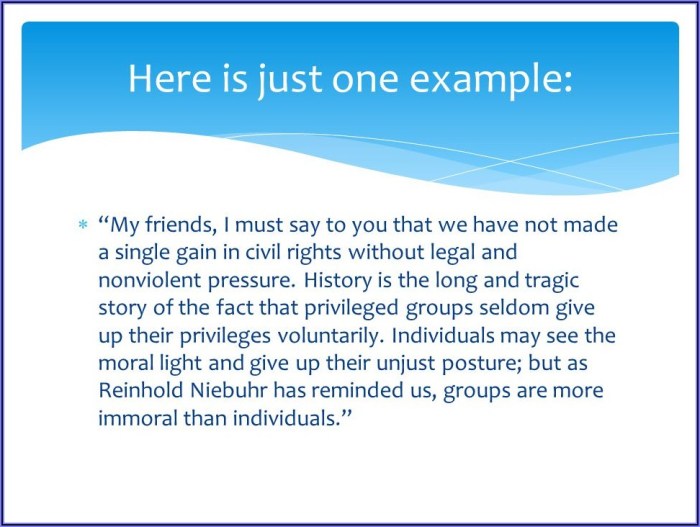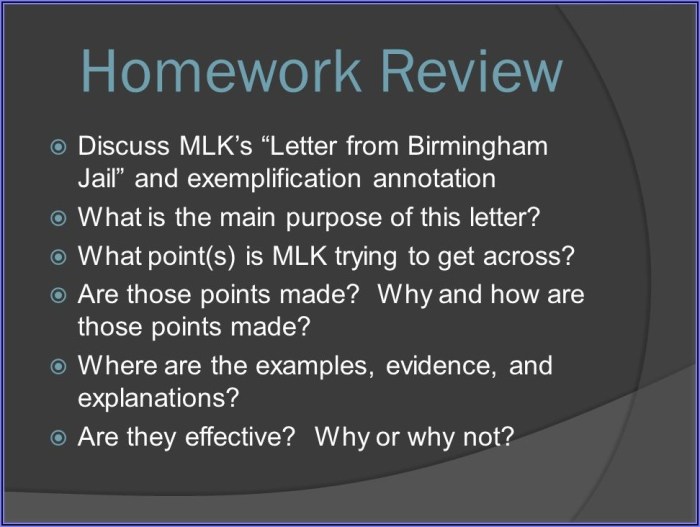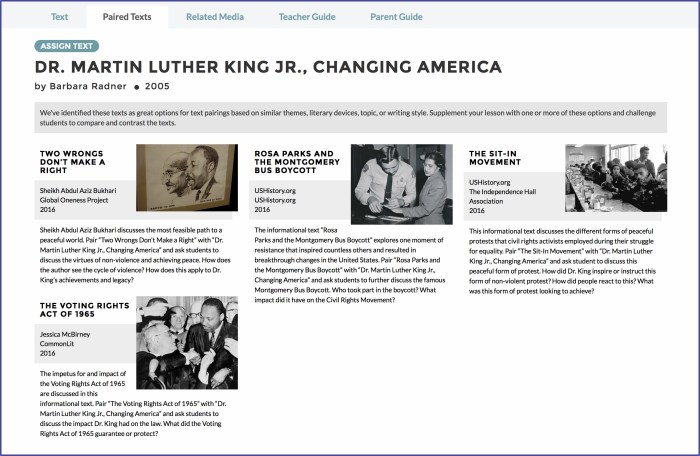Commonlit Letter from Birmingham Jail Answers embarks on an insightful journey into the heart of Dr. Martin Luther King Jr.’s iconic letter, unveiling the profound arguments and strategies that shaped the Civil Rights Movement. This meticulously crafted analysis delves into the historical context, philosophical underpinnings, and lasting impact of King’s powerful words.
The letter, written from the confines of a Birmingham jail cell, serves as a clarion call for nonviolent resistance, challenging the complacency of white moderates and urging the church to embrace its role in the fight for social justice. King’s unwavering belief in the urgency of action resonates throughout the letter, inspiring generations of activists and leaders to confront injustice head-on.
1. Letter from Birmingham Jail Context: Commonlit Letter From Birmingham Jail Answers
Martin Luther King Jr.’s “Letter from Birmingham Jail” was written in April 1963, during his imprisonment following his arrest for participating in nonviolent protests against racial segregation in Birmingham, Alabama.
The main purpose of the letter was to respond to a public statement by eight white clergymen who criticized King’s methods of protest. King defended his actions and argued for the urgency of racial equality.
Key arguments presented in the letter include the following:
- Nonviolent resistance is a legitimate and effective method of fighting injustice.
- The white moderate clergy are complicit in the system of racial oppression.
- The time for racial equality is now.
2. Nonviolent Resistance

King believed that nonviolent resistance was the most effective way to fight racial injustice. He argued that violence would only perpetuate the cycle of violence and hatred, while nonviolence could create a space for dialogue and reconciliation.
King’s views on nonviolence differ from other approaches to civil rights in that he emphasized the importance of love and forgiveness. He believed that even those who opposed him should be treated with respect and compassion.
Nonviolence was a central strategy in the Birmingham campaign, where protesters faced police brutality and arrests with dignity and nonviolent resistance.
3. Injustice and the Church

King criticized the white moderate clergy for their failure to speak out against racial injustice. He argued that they were more concerned with maintaining the status quo than with fighting for justice.
The church, King believed, has a moral obligation to address social injustice. He called on the clergy to use their voices and their influence to challenge racism and promote equality.
Examples of how the church can contribute to the fight for civil rights include:
- Providing safe spaces for dialogue and reconciliation.
- Organizing protests and other forms of nonviolent resistance.
- Educating the public about the evils of racism.
4. The Urgency of Action

King believed that the time for racial equality was now. He argued that the consequences of inaction were too great to ignore.
Inaction, King warned, would lead to further violence and unrest. He called on all Americans to take immediate steps to address the problem of racial injustice.
King’s call for action has influenced the civil rights movement in many ways. It has inspired countless people to join the fight for equality, and it has helped to shape the strategies and tactics of the movement.
5. King’s Legacy and Impact

“Letter from Birmingham Jail” has had a lasting impact on the civil rights movement. It is widely regarded as one of the most important documents in the history of the struggle for racial equality.
King’s ideas and strategies continue to inspire activists and leaders today. His legacy is one of nonviolent resistance, love, and hope.
Examples of how King’s legacy has shaped the fight for social justice include:
- The nonviolent protests of the Civil Rights Movement.
- The work of organizations like the Southern Christian Leadership Conference (SCLC) and the National Association for the Advancement of Colored People (NAACP).
- The election of Barack Obama as the first African American president of the United States.
FAQ Section
What is the main purpose of the Letter from Birmingham Jail?
The main purpose of the letter is to respond to criticism from white moderate clergy who urged King to adopt a more cautious approach to the Civil Rights Movement.
How does King define nonviolent resistance?
King defines nonviolent resistance as a method of social change that seeks to transform the hearts and minds of opponents through love and compassion, rather than resorting to violence or retaliation.
What role does the church play in addressing social injustice, according to King?
King believes that the church has a moral obligation to speak out against injustice and to work actively for social change, using its influence to challenge oppressive systems and promote equality.
Why does King emphasize the urgency of action?
King emphasizes the urgency of action because he believes that the continued denial of civil rights to African Americans is a grave injustice that cannot be tolerated, and that immediate steps must be taken to address this issue.